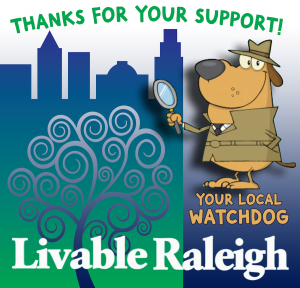
Long-time Raleigh resident and Midtown CAC Chair Larry Helfant recently wrote to Council explaining why Z-54-22 (Peace and West Streets) should NOT be approved. He has given us permission to reprint his email below.
Councilors,
Although this application is for property that is not in Midtown, the similarity to the recent Kane Realty Rezoning application for North Hills is remarkable. You are being asked to approve a rezoning that is inconsistent with the Future Land Use map and inconsistent with previous zoning decisions for height that were previously established for this area. In addition, the developer is trying to sweeten the pot by entering into a Development Agreement to finance the Smokey Hollow Park project. Your decision in this case will not only set a precedent for doing business with the City of Raleigh, it will provide a model for other developers that have provided community benefits on their own dollar as conditional amendments in agreement with community interests.
Let’s put the Development Agreement aside for now. The real question for this case is whether it conforms with the City plan. As noted in the discussion this week, a former planning agreement in 2015 attempted to establish a plan for the future development for the downtown area. The memo introduced in the meeting was never made public, in a public meeting where everything discussed is open to the public. The memo, written by Ken Bowers, was never explained by Mr. Bowers, despite a direct request to do so by the community residents.
Just like North Hills, each application is being discussed on its own merits and not on the impact it will have on the City as a whole. Should buildings that are greater than 12 stories be the first thing people see as they enter downtown? Is a thirty-story building an appropriate structure to wall off and shade a public park? In these times of affordable housing shortages, should an industrial area bound by a railroad that is being converted to mixed use residential development not have some measure of affordability, especially when claiming a near proximity to public transportation? Note that the Smokey Hollow development has an affordable housing conditional commitment, even though the units have not been completed or offered to date. If you can answer these questions, I think you can decide the merits of this application.
Contrary to comments by planning staff, the Comprehensive plan is the guide today, regardless of whether it gets amended in the future. The same is true for the Future Land Use map but, if this application is approved, the area zoning will be changed to accommodate the new building heights for anything being proposed in the future. As a local land use attorney has said, “you have the facts to come to a proper decision on this case without waiting for the details on a future Development Agreement that, in itself, will be controversial and an anchor on the City Budget for the next ten years.
Now, let’s discuss the Development Agreement. The intent is to create a loan agreement, yes – “ loan,” – that is reimbursable to the developer over the next 10 years. All this because the City does not have the funds to support the clean up and construction of a new park. Was there a plan to finance this park as a Capital project? Was it part of the recently passed parks bond? Why does this involve transferring funds from stormwater when it will be needed for the park project as well as other City needs? Is all of this discussion necessary just to decide the fate of a rezoning that is out of scale, beyond the City plan and being proposed in the wrong place geographically? If it was in the core of the City, I think the questions might be altogether different.
Now, final comments on the soon to be created Development Agreement. As the Mayor has said, this has not been done before and for good reason. Most Capital projects come from either infrastructure needs or from City improvements requested by the public. Neither situation is in place here. I suggest that before you journey down this road, you entertain a public forum involving other developers and the public. Like most communities, there is usually a Development Agreement with the local community to achieve a beneficial result. Prime examples of projects that successfully followed that path are the Navaho Road project, Z-45-21, which added affordable housing and staged development, and the Exchange, Z-13-16, which has appropriate neighborhood setbacks and road connectivity, including the widening of Saint Albans (part of Midtown area plan) at developer expense. Can you imagine the future of community negotiations once a pathway to Development Agreements is established?
I know that there is an effort to defer this decision until planning and finance come up with an agreement. But it isn’t needed if you decide the bigger issues stated above – namely what is best for downtown Raleigh as a whole. Study the data as suggested and deny this application.
In the words of former Mayor McFarlane “The City has a development plan. Just follow it!”
If you appreciate the kind of reporting we bring to you
|
Please donate $10 or $20, Thanks for supporting |
 |

